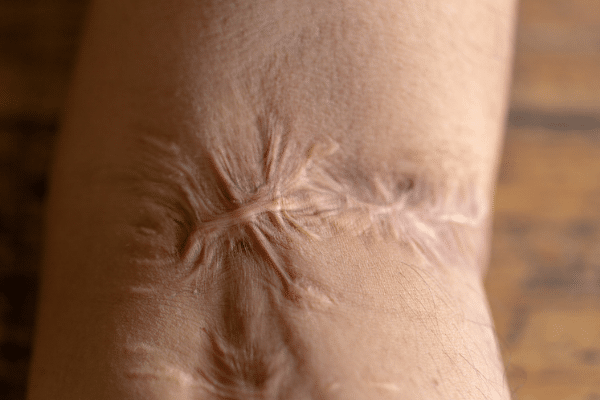Scar tissue isn’t just the ugly bit of skin that heals after a bad cut. Scar tissue can form inside the body from minor injuries to massive accidents or surgery.
Collagen fibres have a nicely knit basketweave formation that allows tissue to keep its strength and integrity. When trauma occurs, collagen fibres are laid down for repair in a cross-linked pattern that flows only in one direction, instead of the nice basketweave, and creates a line of pull and tension in the tissue. This scar tissue can attach to muscles, nerves, bones, and other surrounding healthy tissue, limiting movement or even strangulating tissue.
-
Scar tissue between muscles and bones can cause limitation in movement, and effect performance.
-
Scar tissue can interfere with lymphatic tissue, it can cause a build up of fluid leading to chronic swelling.
-
If a nerve gets stuck or pinched by scar tissue formation, it can cause a shocking, shooting-like pain down it’s path.
It is quite common for the average person to collect small amounts of scar tissue from everyday movements and daily habits. Training regularly at the gym causes micro trauma and promotes the growth of scar tissue. This same mechanism of injury is present when sitting at a desk all day, typing away on the keyboard. Scar tissue can form anywhere in the body.
Registered Massage Therapists I often notice scar tissue in patients in the shoulders, neck muscles, forearms, calves, hands, and feet. Though scar tissue on its own isn’t harmful, over time it can cause limitations, pain, and weakness.
How can your massage therapist help break down severe scar tissue?
Fascial Therapy:
This technique is done dry without any lotion. The therapist places their hand over the adhesion site and applies pressure and tension into or against the resistance. This can separate the small adhesions of connective tissue away from surrounding muscles, bone, and tissue. This form of therapy can feel like tingling, burning, or stinging. Every time the adhesions are broken, water and heat are released, causing the area to become red and hot. This technique is very effective at releasing adhesions and superficial scar tissue that the client may find limiting or painful.
Friction Therapy:
This technique is often quite painful, however very effective at treating larger unidirectional scars caused by surgeries or other injuries. Larger amounts of collagen are deposited in order to protect to the skin and underplaying tissues. These deeply adhered fibres can cause unsightly lumps or dimpling in the skin and cause severe restrictions in movement. For this treatment, the therapist uses reinforced fingertips or knuckles in order to pin the tissue and strum against it vigorously. This kind of “friction” work can help break down excessive collagen. This technique cannot eliminate the scar, however, dimpling of the skin can be greatly reduced, improving its appearance. This technique is also very effective at restoring range of motion for those that were otherwise restricted in their day-to-day tasks.
If you suspect that scar tissue may be causing you pain, swelling or limiting your mobility, book an appointment with one of our experience Registered Massage Therapists. Our goal is to help you optimize your health and feel amazing!


